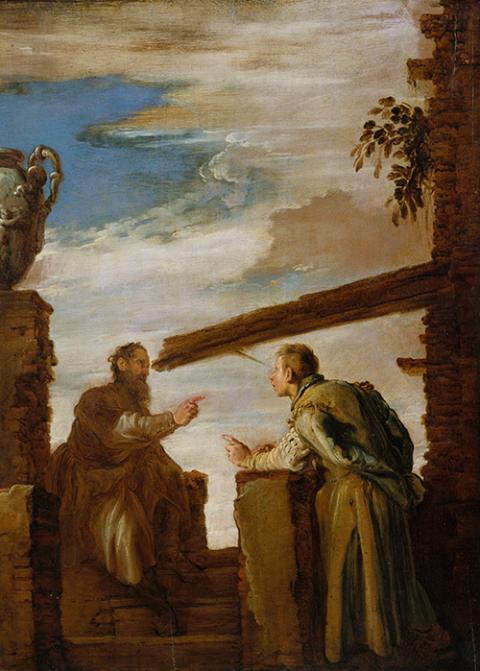
Detail from Domenico Fetti's "The Parable of the Mote and Beam," based on Jesus' admonition in Luke 6:41-42 (Metropolitan Museum of Art)
How can we promote fruitful dialogues during a time in which contemporary public debates are dominated by what the great theologian Howard Thurman called the "three hounds of hell": fear, deception/hypocrisy and hate? Domenico Fetti's intriguing painting "The Mote and the Beam," as well as the parable of Jesus on which it is based, provides some helpful insights.
In Fetti's painting, a bearded older man sits at the top of a small set of steps. He raises his right hand and points his index finger at a younger man on the right, apparently lecturing the younger man energetically. The younger man stands, leans slightly toward the older man and rests his arms on a wall between them. His left hand, in response to the older man's gesture, is slightly raised, much less energetically, with his index finger pointing back at the older man.
What first grabs the viewers' attention is a massive beam that juts out of the wall on the right, stretches three-fourths of the way across the center of the painting and almost touches the left eye of the older man. In contrast, a splinter from that beam juts out in almost the opposite direction, coming very close to the younger man's eye.
The older man comically seems nonplussed by the beam nearing his eye; he continues his stern lecture of the younger man, who, in contrast, seems surprised by the splinter near his eye. The face and upper body of the younger man are, besides some brilliant white clouds in the background, the brightest part of the painting. It is almost as if a spotlight shines upon him.
Tellingly, the older man is almost completely in shadows, with only his right hand, upper arm and part of his right knee in the light. The older man is in both physical and metaphorical darkness, and the weakness of his argument — whatever it is — is reinforced by the fact that his left hand uses the back wall as a support.
Domenico Fetti, the underrated artist who painted this arresting image, began his career in Rome, but his reputation largely depends upon the series of parable paintings he created in Mantua near the end of his career (1618–21), works that reveal the fullest expression of his art. Fetti interprets Jesus' parables within the context of the Catholic Reformation, and these visual teachings reflect, as the Council of Trent urged, the spiritual instruction of the church. His parable paintings do so with simplicity and clarity but in personal, not dogmatic, terms, and with a clear focus on the welfare of human beings.
Advertisement
"The Mote and the Beam" is one of Fetti's earliest paintings in this series. The image portrays a proverbial saying of Jesus that is labeled a parable in Luke. Jesus hyperbolically asks how people can see a speck (mote) in someone else's eye but not notice the log (beam) in their own eye and then advises people to take the log out of their own eye so they can see clearly enough to remove the speck from the eyes of others.
Once people seriously engage in self-reflection, they can more clearly see their own faults and limitations, which should lead to, Jesus says, a more compassionate and merciful assessment of the faults of others.
In contrast to most of Fetti's parable paintings, "The Mote and the Beam" uses satire as unrealistic as the hyperbolic saying itself. Jesus' humorous yet serious warning is clearly and comically conveyed: Human beings tend to criticize various faults in others while minimizing or even overlooking their own.
Jesus' admonitions are often difficult to implement, and the task is especially arduous when applied during a pandemic that is prolonged by people hesitant or even adamant about not taking simple actions to protect themselves and their neighbors. It seems that the "beams" are in their eyes, not ours, and that they are blind to both the danger and the solutions — and maddeningly so to the rest of us.
In addition, some influential voices — for fame, power and/or profit — deliberately mislead others about actions they should take to protect themselves and their neighbors, such as convincing people that the COVID-19 vaccines are unnecessary, or harmful, or a "personal choice" that does not affect others.

"The Parable of the Mote and Beam" (circa 1619) by Domenico Fetti (Metropolitan Museum of Art)
In such cases, it seems clear why Jesus prefaces the mote/beam parable in Luke with the parable about the blind leading the blind, with them all falling into a pit. Disaster is sure to follow, just as Jesus warned.
The arguments against masks, social distancing and vaccines are scientifically false, so their opponents are in error, sometimes tragically so. To be clear, Jesus' admonition not to "judge" other human beings in this section of Luke (6:37) does not mean that we should avoid correcting such erroneous beliefs and behaviors; it means instead that we should not judge in a condemnatory way (as noted in the same verse) and that our critiques should be merciful, generous, loving and intended to be redemptive, all of which are included in a humble acknowledgement of our own failings — noting the beams in our own eyes.
A PRRI poll provides hope about the ability to convince some reluctant people to be vaccinated. The poll indicates that faith-based approaches can be effective for those who are hesitant about or even refusing to get the COVID-19 vaccine. For example, acceptance of the vaccine increased by double digits from March to June 2021, among both Hispanic and white Catholics in the United States, with support from both groups reaching around 80%.
Jesus' teachings provide other general guidelines for how to promote fruitful discussions with those hesitant or resistant to getting vaccinated: Jesus assures his followers, then and now, that God is good and that God loves them, cares for them and showers them with good things. Jesus proclaims that our response of faith to God's love should be to act toward other human beings as God treats us: with love, compassion and by working actively for their well-being, to be merciful, just as God is merciful.
In contrast to the beloved community that attempts to put Jesus' commands into practice in their daily lives, some malevolent voices in today's society try to create a warped "community" that is based on fear or even hatred of the "other." These "blind" guides use, albeit in a different context, what Thurman named the "hounds of hell" — fear, deception/hypocrisy and hate — to build support.
Such hounds of hell, Thurman warned, initially can give a false sense of meaning or purpose to one's life, but ultimately, like an untreated cancerous growth, they destroy the self from within.
Thurman argued that the best response to these hounds of hell should be the ethic central to Jesus' message: to love God and then one's neighbor as oneself. True community, Jesus says, is built by the children of God who love other human beings and work actively for their neighbors' well-being, which, once you reflect fully on the implications, ultimately also includes their own well-being.
That is the foundation on which the hellhounds of fear, deception and hate can be combated.








